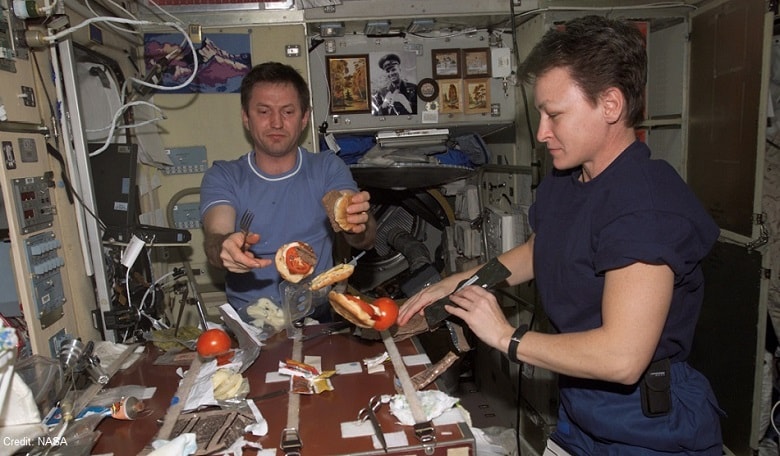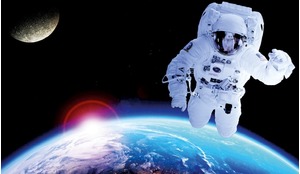We’ve come a long way since the Gemini and Apollo missions served up tasteless, dehydrated food in plastic pouches. Now, Michelin-starred chefs cook up space recipes, 3D printers are being harnessed to combine raw ingredients and we know a lot more about the psychology of taste and smell. But there remain considerable challenges to making astronauts self-sufficient in food production over voyages lasting several years.
Ever since the first human left on a journey far from home, one of the key questions has been: what am I going to eat? This is a far from a trivial question, and nowhere more so than in space where, until now, all there is to eat is the carefully packaged food you’ve brought with you. Food isn’t only a matter of basic survival, though, it’s a massive logistical challenge. Every day each astronaut on the ISS requires around 5kg of food and water. Although the recent production of a decent lettuce crop by NASA’s Veg-01 experiment is a promising development - 44 home-grown heads of lettuce were harvested on the ISS in August 2015 - the significant degree of self-sufficiency that will be required for long-term and long-range missions remains some way off.
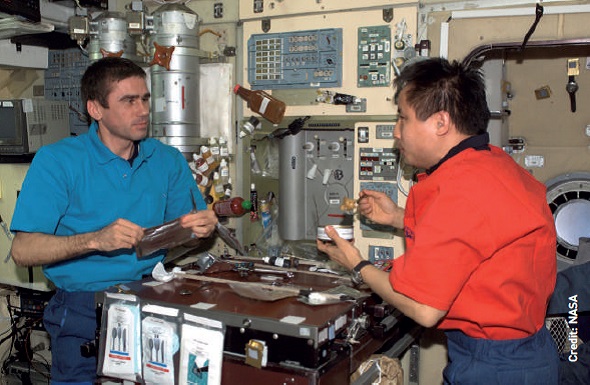 Expedition 7 Commander Yuri Malenchenko (left) and Science Officer Ed Lu pictured in the ISS galley, with utensil packs attached to the table and floating condiment bottles.
Expedition 7 Commander Yuri Malenchenko (left) and Science Officer Ed Lu pictured in the ISS galley, with utensil packs attached to the table and floating condiment bottles.
Scientists have grappled with the challenges of feeding astronauts since the beginning of human space flight. The total payload of every vehicle launched is a critical factor, with storage space at a premium and every gram adding to the expense. So technical solutions to the problem of food and water supply have been at the forefront of planning from the beginning. The dream of a meal in a pill may have been abandoned, but it’s easy to understand the appeal for early technologists of dehydrated foods that could be rehydrated with the waste water produced by fuel cells. There were also attempts to develop food ‘cubes’, carefully coated in edible gums to avoid crumbs, that could be rehydrated by the astronaut’s own saliva.
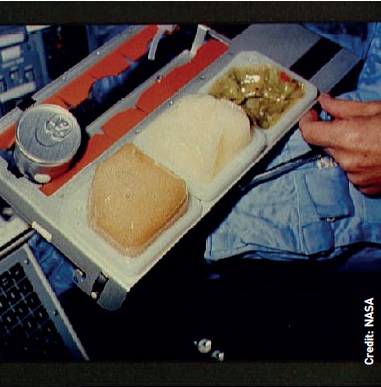 Above right: ’Meal A’ for a Gemini mission of the mid 1960s: hand wipe and food cubes are on the right and fruit juice is in the centre.
Above right: ’Meal A’ for a Gemini mission of the mid 1960s: hand wipe and food cubes are on the right and fruit juice is in the centre.
Experiments with 3-D food printing are now underway, but it is difficult to see how this technology could provide a complete answer to the question of how to feed a crew easily on a long-duration mission. In general, food is ‘printed’ from raw ingredients - a printed pizza still needs to go into the oven - meaning that besides the need to store sufficient quantities of processed food ‘inks’, cooking facilities need to be in place. Tests are at an early stage, and it’s possible they’ll lead to exciting results. However, it also seems possible that 3D printing will join the annals of excessively technical solutions, inadequate to meet a fundamental human need for food that rises above the functional.
Food 3D-printed from raw ingredients still needs to go into the oven so cooking facilities need to be in place.
Nonetheless, the challenge of producing food on board spacecraft must be solved to enable deeper exploration of space. Currently, the ISS stores about six months’ worth of food, and is regularly resupplied. However, there is a limit to the range of resupply vehicles, and such trips become less and less feasible the further a mission travels from Earth. If long-term expeditions are to become a reality, requiring up to five years of food supply (en route, at the destination, and for the return journey), crews will have to grow and process their own food.
Michelin space man
Over a decade ago, ESA defined the nine basic food plants that should be grown in space greenhouses and supply at least 40% of the astronauts’ diet, whether on the Moon, other planets or in space vehicles. They are: rice, onions, tomatoes, soya, potatoes, lettuce, spinach, wheat and spirulina alga, and they remain the central focus of research. Michelin-starred French chef Alain Ducasse even devised 11 magnificent dishes for future space chefs to create from these ingredients, from ‘potato and tomato mille feuille’ to ‘spirulina gnocchi’. While clearly not impossible to achieve, these refined and beautifully presented recipes highlight the obstacles associated with growing and cooking from scratch in space conditions.
The widely acknowledged challenge remains to make it possible to produce enough plants in a self-sustaining, closed-loop ecosystem to sustain space explorers in the long term. The second challenge, less widely discussed but a crucial part of the story, is how any crops grown will be processed. Whereas a lettuce or tomato - or even onions and spinach - can be eaten raw, straight from the plant, the other items on the list of nine food plants require significant intervention before becoming truly edible.
Most foods release more calorific and nutritional value when eaten cooked instead of raw, making cooked food the preferred option. Indeed, uncooked soya is toxic to humans in its raw form, and must at least be boiled in water before consumption. Many of the high protein products it is used for (such as tofu) also require a fermentation process. Rice and wheat must be milled before they can be used in cooking, a not impossible but messy process that will need careful containment and a destination for the waste.
All this must be dealt with before Mars travellers even get their ingredients to the kitchen and face the challenge of cooking, whether from M. Ducasse’s recipes or not. The production of even an ostensibly simple dish like gnocchi requires multiple cooking processes and the use of many pre-processed ingredients: boiling or steaming and mashing the potatoes, mixing with flour and seasonings, forming into shape, and boiling again to cook, producing a sauce. It’s little wonder, then, that ESA estimates that the results of its current experimental programme will not be fully known until mid-century.
The impact of space travel on the human body means that good nutrition is vital if space travellers are to arrive at their destination healthy. Conditions in space are such that muscles waste, bone density decreases and red blood cells are lost; the body is exposed to increased levels of radiation; and more than half of all astronauts suffer from space sickness. Even on the relatively short Gemini and Apollo missions, these effects were noted and astronauts needed significant recovery time on their return to Earth.
While a regular exercise regime of resistance training now helps retain a degree of astronaut strength, the food consumed plays a crucial role too, mitigating and protecting against many of the effects of space travel. However, a single-minded focus on nutritional value isn’t enough: inconvenient as it may be, food needs to be palatable and appealing to the senses.
Stimulating appetites
In the early era of spaceflight, when dehydrated foods were contained in plastic pouches that needed to be injected with water and ‘massaged’ as they rehydrated, before being squeezed directly into the mouth, it’s difficult to see how even the most brilliantly conceived ‘chicken and gravy’ or ‘spaghetti with meat sauce’ could have survived the process to supply anything approaching an appetizing meal. Despite the efforts of food technologists, astronauts lost weight on every NASA mission until Skylab (1973-1979), though in retrospect it isn’t hard to understand why Gemini astronauts didn’t enjoy their potatoes, given that they only had cold water with which to rehydrate them.
As the focus of missions switched to longer-term space living, for example on Mir or the ISS, there was an increasing recognition of the importance of food not only for survival but also for its psychological and socio-cultural value. Gemini and even Apollo astronauts were expected to be stoical heroes, unconcerned with the rations supplied on what was, effectively, a ‘camping trip’. Gus Grissom had complained about the food, largely based on the technological priority given to its production: he joked that the main pre-requisites were that it should make no mess, emit no smell, and above all have no flavour, but the administration remained unmoved.
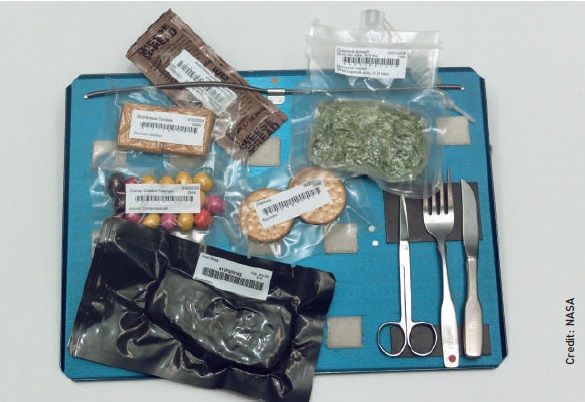 A tray bearing bags of ISS food and utensils, including repackaged M&Ms, shortbread biscuits, crackers, creamed spinach and steak.
A tray bearing bags of ISS food and utensils, including repackaged M&Ms, shortbread biscuits, crackers, creamed spinach and steak.
At this stage, it was explicitly stated that one of the least useful elements in the development of food for astronauts was evidence from interviews with them about their own stated likes and dislikes. In this environment, any deviation from the plan was rigorously dealt with: John Young received a congressional reprimand after he smuggled one of Grissom’s favourite corned-beef sandwiches onto their Gemini 3 flight in March 1965.
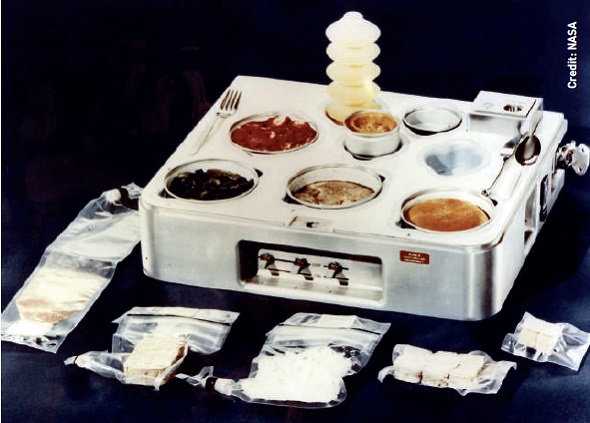 The Skylab food heating and serving tray from 1970, complete with food, drink, and utensils.
The Skylab food heating and serving tray from 1970, complete with food, drink, and utensils.
Later mission participants, who were spending longer and longer durations in space, were more fortunate. It became clear that they not only needed to be fed, but also to have food they could look forward to and enjoy together. Food of this kind could even be used to build team spirit. When Shannon Lucid realised there was a fridge on Mir, she requested packs of Jell-O, which could easily be mixed with water and left to set. The Sunday night Jell-O tradition became a standout feature of her successful 1996 mission with her fellow Russian cosmonauts.
Gus Grissom joked that space food should make no mess, emit no smell, and above all have no flavour
To be beneficial, of course, food has to be eaten, making stimulation of astronauts’ appetites one of the major challenges for food technologists. This isn’t a straightforward matter. Nutritional balance plays its part, as low zinc intake can significantly affect the senses of taste and smell, and make food seem less tasty and appealing. More importantly perhaps, as it’s far less easy to mitigate, microgravity and weightlessness makes fluids in the body shift to the head, which has a similar effect to blocked sinuses. This severely reduces the senses of smell and taste, and changes the perception of flavours that might have seemed perfectly delicious when the astronauts tested the dish on Earth. Worse, it could have the opposite effect, as Skylab astronauts discovered.
A cure for odour fatigue
As astronaut Joseph Kerwin describes it, they all craved and rapidly ate their way through the spicy and oniony German potato salad no-one had liked much on Earth, and which was only sent up as emergency back-up rations. It certainly helps explain the appeal of foods that provide strong chemical stimulation in the mouth, like horseradish, and the continued consumption of large quantities of chilli sauce and even raw garlic on board. These are perfectly understandable attempts to make sure the food produces a sensation and seems to taste of something. The sense of smell is directly linked to the ability to taste and, given the evidence about shifts in taste perception, it’s hardly surprising that the sense of smell is reported as being considerably impaired in space. It is not absent, however.
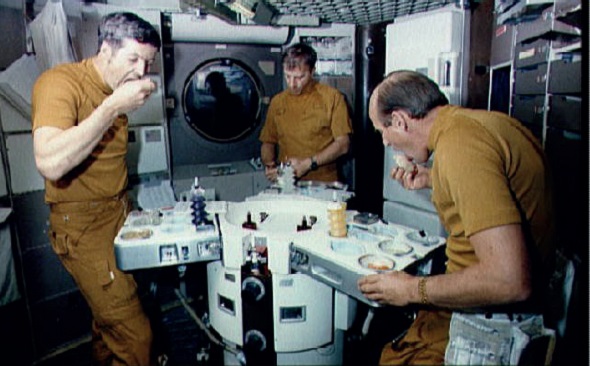 A Skylab crew eat from their trays at the Raymond Loewy-designed table in 1973. L-R: Joseph P. Kerwin, Paul J. Weitz and Charles Conrad Jr.
A Skylab crew eat from their trays at the Raymond Loewy-designed table in 1973. L-R: Joseph P. Kerwin, Paul J. Weitz and Charles Conrad Jr.
A few try to describe the near absence of smell - it is like cold metal, or, as NASA astronaut Jerry Lineger described it after his stint on Mir, like “spent logs in a cold fireplace.” The experienced cosmonaut Alexei Leonov gave British cosmonaut Helen Sharman a little handful of fragrant local Kazakh wormwood to put in her pocket before she launched to the Space Station, saying “There’s nothing much to smell up there and this will remind you of home.”
While in some cases it may be a blessing in disguise, the lack of normal air convection on board means that odours do not move through the environment in the same way as on Earth. Astronauts experience odour ‘fatigue’ from the layering of various human smells in a space where no window can ever be opened. On the rare occasions that a fresh odour is experienced, for example when a delivery arrives, it is reported with incredible excitement. That’s as true today on the ISS as it was on Mir in the 1980s.
In fact, these are often the most enthusiastic descriptions of anything apart from the awe-inspiring view. This is not necessarily as surprising as it might sound. In 1978, the USSR conducted the Opros questionnaire on board Salyut to help psychologists correlate physical and mental health. Sense of smell was considered an important enough factor in the psychological condition of cosmonauts to be included with the analysis of eating and sleeping habits.
In the face of the many and varied technical challenges of getting a human mission to Mars, it may seem trivial to think about what’s for dinner. But in fact this question is one of the most pressing issues for the future of human space travel. If we can’t feed ourselves, we cannot survive. In many ways the challenges of eating in space are quite similar to those we face on Earth. We need to make sure we have the right quantity of food, that it supplies a good nutritional balance, and that our ingredients let us produce something that tastes and smells good enough to make us want to eat it.
It seems that the answers to the space food challenge need to be equally Earth-like. Far from a technological future in which astronauts can live on pills, tubes and cubes, or even print their food from pre-selected combinations of preserved goo, the future of food in space lies with the farmer-astronauts. Perhaps it’s the case that the closer to home our food can make us feel, the further we’ll be prepared to travel.





